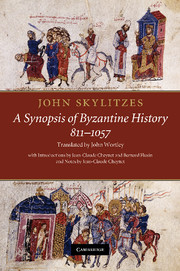Book contents
- Frontmatter
- Contents
- The English translator’s Preface
- Introduction
- Re-writing history: John Skylitzes’ Synopsis historion
- Foreword
- Chapter 1 Michael I Rangabe, the Kouropalates [811–813]
- Chapter 2 Leo V the Armenian [813–820]
- Chapter 3 Michael II the Stammerer [820–829]
- Chapter 4 Theophilos [829–842]
- Chapter 5 Michael III, the son of Theophilos [842–867], and his mother Theodora [842–862]
- Chapter 6 Basil I Kephalas, the Macedonian [867–886]
- Chapter 7 Leo VI the Philosopher (the Wise) [886–912]
- Chapter 8 Alexander [912–913]
- Chapter 9 Constantine VII, Porphyrogennetos [913–959]
- Chapter 10 Romanos I Lekapenos [919–944]
- Chapter 11 Constantine VII [944–959]
- Chapter 12 Romanos II the Younger [959–963]
- Chapter 13 Basil II Bulgaroktonos and Constantine VIII [976–1025]
- Chapter 14 Nikephoros II Phokas [963–969]
- Chapter 15 John I Tzimiskes [969–976]
- Chapter 16 Basil II and Constantine VIII bis [976–1025]
- Chapter 17 Constantine VIII [1025–1028]
- Chapter 18 Romanos III Argyros [1028–1034]
- Chapter 19 Michael IV the Paphlagonian [1034–1041]
- Chapter 20 Michael V Kalaphates [1041–1042]
- Chapter 21 Constantine IX Monomachos [1042–1055]
- Chapter 22 Theodora [1055–1056]
- Chapter 23 Michael VI the Elder/Stratiotikos [1056–1057]
- Glossary
- Bibliography
- Index
- References
Chapter 15 - John I Tzimiskes [969–976]
Published online by Cambridge University Press: 05 July 2014
- Frontmatter
- Contents
- The English translator’s Preface
- Introduction
- Re-writing history: John Skylitzes’ Synopsis historion
- Foreword
- Chapter 1 Michael I Rangabe, the Kouropalates [811–813]
- Chapter 2 Leo V the Armenian [813–820]
- Chapter 3 Michael II the Stammerer [820–829]
- Chapter 4 Theophilos [829–842]
- Chapter 5 Michael III, the son of Theophilos [842–867], and his mother Theodora [842–862]
- Chapter 6 Basil I Kephalas, the Macedonian [867–886]
- Chapter 7 Leo VI the Philosopher (the Wise) [886–912]
- Chapter 8 Alexander [912–913]
- Chapter 9 Constantine VII, Porphyrogennetos [913–959]
- Chapter 10 Romanos I Lekapenos [919–944]
- Chapter 11 Constantine VII [944–959]
- Chapter 12 Romanos II the Younger [959–963]
- Chapter 13 Basil II Bulgaroktonos and Constantine VIII [976–1025]
- Chapter 14 Nikephoros II Phokas [963–969]
- Chapter 15 John I Tzimiskes [969–976]
- Chapter 16 Basil II and Constantine VIII bis [976–1025]
- Chapter 17 Constantine VIII [1025–1028]
- Chapter 18 Romanos III Argyros [1028–1034]
- Chapter 19 Michael IV the Paphlagonian [1034–1041]
- Chapter 20 Michael V Kalaphates [1041–1042]
- Chapter 21 Constantine IX Monomachos [1042–1055]
- Chapter 22 Theodora [1055–1056]
- Chapter 23 Michael VI the Elder/Stratiotikos [1056–1057]
- Glossary
- Bibliography
- Index
- References
Summary
After Nikephoros died, John Tzimiskes assumed responsibility for the Roman government with Basil and Constantine, the sons of Romanos [II], as co-emperors; Basil was in the seventh year of his life, Constantine in his fifth. [John] immediately summoned Basil the parakoimomenos by night and made him his associate in power. It was in no small measure owing to this man that the emperor Nikephoros gained the imperial throne, for which he was appointed president [of the Senate] – a position which did not exist before; Nikephoros was the first to name anybody to it. [John made this man his associate] because he had been involved in affairs of state for many years, under Romanos [I] the Elder, his own father, then under his half-brother, Constantine [VII] Porphyrogennetos. Many times he had campaigned against the Hagarenes and he was especially skilled in smoothly adapting himself to difficult situations. He quickly took matters in hand and expelled all those who remained in favour of Nikephoros. He exiled Leo the kouropalates to Lesbos and his son, Nikephoros the vestes, to Imbros. He wrote to Bardas the younger, then duke of Chaldia and Coloneia, relieving him of his command and transferring him to Amaseia. And he dismissed those others who held civil or military commands from their positions, appointing his own men, supporters of the new emperor. [285] He permitted those whom Nikephoros had exiled to return, especially those bishops he had exiled for refusing to sign the bill by which that emperor sought to restrict and humiliate the church, as this narrative has already reported.
After taking these measures, in that same night the emperor, accompanied by only a few men, went to the Great Church without the slightest apprehension; his intention was to receive the diadem at the hand of the patriarch. But when he was about to enter the church, Polyeuktos would not allow it. He said that a man whose hands were dripping with the steaming blood of a newly slain kinsman was unworthy to enter a church of God; that he had better start showing deeds of repentance and thus gain permission to tread the floor of the house of the Lord. John quietly accepted a penance and obediently declared that he would perform it all.
- Type
- Chapter
- Information
- John Skylitzes: A Synopsis of Byzantine History, 811–1057Translation and Notes, pp. 271 - 297Publisher: Cambridge University PressPrint publication year: 2010

